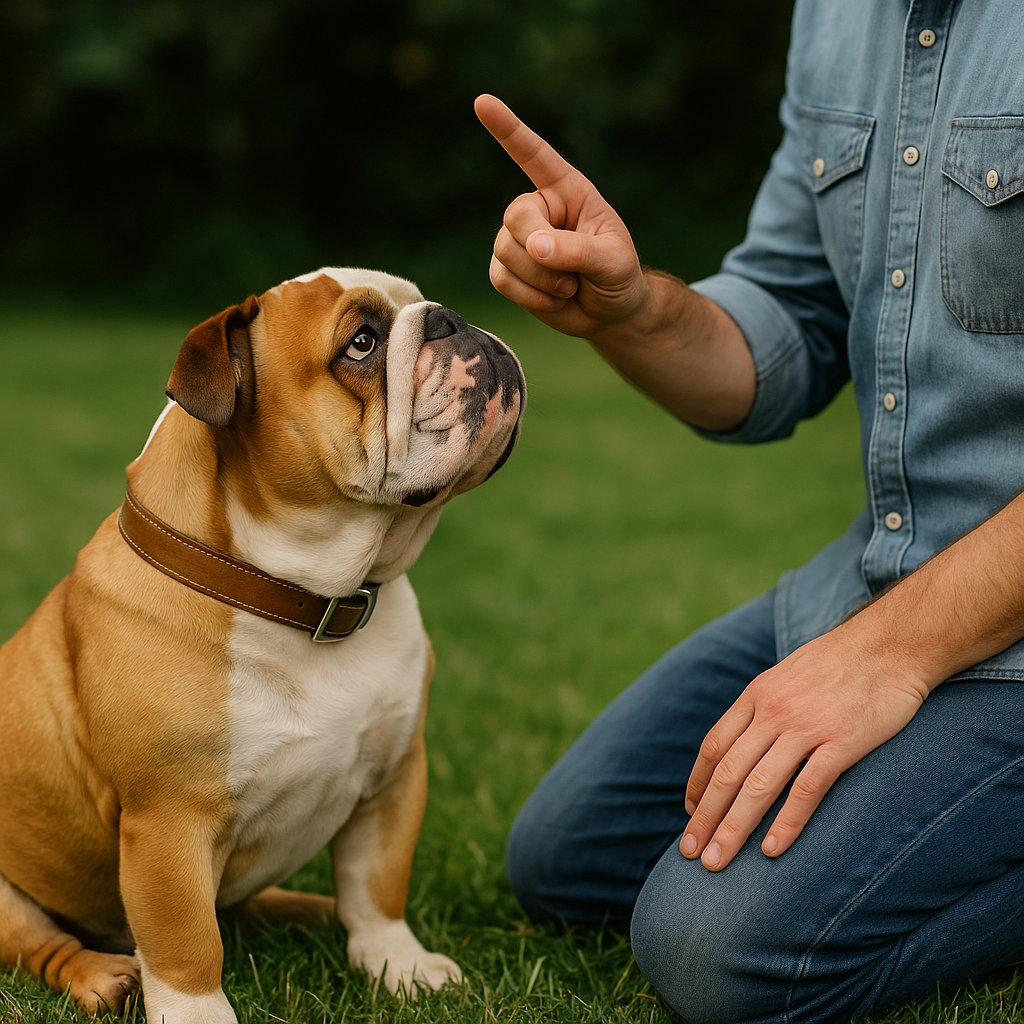The Bulldog is one of the most beloved breeds due to its calm, affectionate, and loyal nature. However, it’s also known for being somewhat stubborn, which can present a challenge when it comes to training. The good news is that you don’t need to yell, punish, or instill fear to achieve good results. With patience, consistency, and positive reinforcement techniques, it is entirely possible to train a Bulldog in a respectful and effective way. In this article, I’ll explain how to do it.
Understand the Bulldog’s Personality
Before starting any kind of training, it’s essential to understand how a Bulldog thinks and behaves. This breed is intelligent but doesn’t respond well to authoritative commands. It tends to do what it wants unless it feels motivated or clearly understands what’s expected.
A Bulldog is not a hyperactive dog nor does it have a constant desire to please like a Labrador or Border Collie. Bulldogs need a reason to cooperate, and those reasons are usually related to affection, food, and play.
Positive Reinforcement: The Foundation of Good Training
Positive reinforcement means rewarding the behaviors you want the dog to repeat. This can involve verbal praise, petting, healthy treats, or games. It’s much more effective and healthy than punishment or intimidation-based methods.
For example, if your Bulldog sits when asked, reward it with a small treat and a cheerful voice saying “Good job!” If it stays still while you put on the leash, reward that behavior too. In this way, the dog will learn which actions bring positive outcomes.
Be Consistent with Commands
One of the most common mistakes is changing words or gestures each time a command is given. If one day you say “come” and another day “here,” the dog may become confused. Always use the same words for each command and pair them with a clear, consistent gesture.
For example:
To sit: say “sit” and point your hand downward.
To come: say “come” and open your arms or clap softly.
To stay: say “stay” and raise your palm toward the dog.
Consistency between words, tone of voice, and body language is key for your Bulldog to understand what you’re asking.
Keep Training Sessions Short and Fun
Bulldogs don’t have long attention spans, so it’s better to have short training sessions—5 to 10 minutes—multiple times a day rather than one long session. If the dog gets bored or tired, it won’t pay attention and the session won’t be productive.
Always end on a positive note. Even if your dog didn’t get everything right, finish with a command it knows, reward it, and leave the session on a successful note. This will motivate the dog to want to participate next time.
Use Appropriate Treats
Food rewards are excellent motivators for Bulldogs, but it’s important to choose healthy treats in small portions. You can use carrot pieces, seedless apple slices, dog-specific biscuits, or low-fat commercial treats.
Avoid human food with salt, fat, or spices, as these can harm your dog’s health. If your Bulldog tends to gain weight, slightly reduce its daily meal portions to account for the treats given during training.
Don’t Yell or Use Physical Punishment
Even though training a stubborn dog can be frustrating, yelling or hitting is never the answer. These methods cause fear, insecurity, and can damage the bond between you and your dog. Bulldogs are sensitive animals—if they’re spoken to harshly or punished physically, they may withdraw, stop obeying, or even show signs of stress or aggression.
If your dog does something wrong, simply ignore the behavior, redirect it to a correct one, and reward it when it does it right. For example, if it chews on something it shouldn’t, say “no” firmly but calmly, remove the object, and offer a toy it is allowed to chew.
Also Reinforce Calm Behaviors
Often, we only pay attention when the dog does something wrong, but it’s very important to also reinforce calm behaviors. If your Bulldog is quietly resting, sitting next to you without asking for attention, or walking calmly, use that opportunity to reward it with a gentle pet or a kind word. This strengthens desirable behaviors and helps prevent future issues.
Socialization Without Pressure
Training a Bulldog also involves teaching it to live peacefully with other dogs, people, children, and in different environments. To do this without using punishment, it’s essential to introduce these situations gradually and in a positive way. If you force the dog to interact when it’s afraid, or scold it for barking at another dog, you might make things worse.
The key is to reward calm behavior in the presence of new stimuli. If your Bulldog behaves well near another dog—even just by observing quietly—give it a treat. This way, it learns to associate those moments with something good.
Be Patient: Every Dog Learns at Its Own Pace
Training isn’t a linear process. There will be days when your Bulldog seems to understand everything, and others when it doesn’t want to cooperate. This is completely normal. The important thing is to stay calm, avoid punishment, and continue reinforcing the behaviors you want.
Every dog has its own learning rhythm. Some Bulldogs learn quickly; others need more repetitions. But with consistency and love, they all eventually learn.
Trust Is the Best Result
Training your Bulldog without punishment isn’t just possible—it’s the best approach for their emotional well-being and your relationship with them. A dog trained with respect and positive reinforcement will be more confident, calm, secure, and connected to its human family.
Remember that training isn’t just about obedience—it’s about building clear communication, strengthening your bond, and giving your Bulldog a peaceful life. With love, patience, and consistency, you’ll achieve more than just good behavior—you’ll gain a loyal and happy companion.
